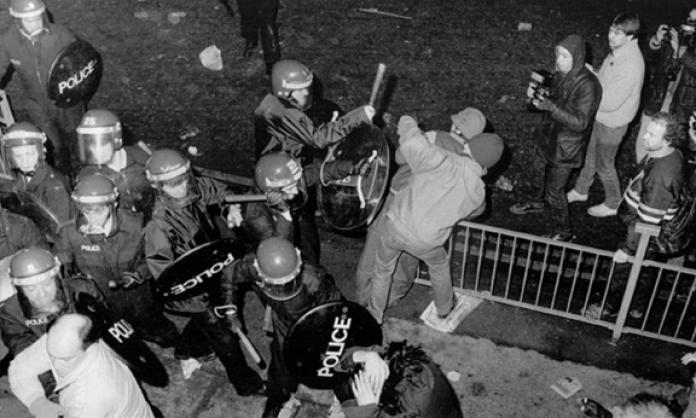The 1980s were brutal years for workers and their unions as the neoliberal wave crossed the world. With it came austerity and an employers’ offensive. Strong unions were among the first targeted. In Australia, it was the Builders Labourers and the Pilots and in the US, the Air Traffic Controllers. All were defeated in long and bitter disputes.
In the UK, the miners’ union, which had brought down the previous Tory government, was smashed by Margaret Thatcher’s Conservatives in 1984-85. The next year, media mogul Rupert Murdoch took on the militant printers unions. They were defeated in what has become known as the Battle of Wapping. Within a few years, all of Murdoch’s newspapers were de-unionised, workers were represented by a powerless in-house association, and News’ profits quadrupled between 1985 and 1988.
But it need not have been so. In every case there was an alternative, a combined union fight back, that could have smashed the bosses. Murdoch, millions in debt over the Fox Network purchase a few years earlier, was vulnerable. A serious campaign could have bankrupted him.
The print unions were strong. The Miners’ Union’s Granville Richardson explained, “When the Sun called the Silverwood miners “the Scum of the Earth”, the printers put their necks on the block for us … They stopped the presses”. Printers had a long history of supporting other unions’ struggles as well as the anti-fascist and peace movements.
But the balance of class forces had changed with the defeat of the miners. Rising unemployment and draconian industrial laws helped create a climate of fear. This left workers ill equipped to deal with the introduction of new technology by a ruling class determined to slash costs to protect profits.
It was in this climate that the Battle of Wapping was waged. It was a vicious class war in East London’s Docklands, a location that was earlier a bulwark of working class solidarity. It brought out the full force of the state and the Thatcher government against the print workers and their supporters.
What was it all about? Newspapers around the world were automating everything from journalism to layout and printing. Rupert Murdoch, owner of a stable of newspapers – the Times, the Sunday Times, the Sun and News of the World – or News International, was at the forefront of that move. For the first time since the 1600s, English newspaper production would be moved away from its home in Fleet Street to a state of the art building in the Docklands.
After the move was announced, News International and the unions began negotiating terms and conditions for the new site. Murdoch played hardball from the start, demanding that workers accept flexible working, a no-strike clause and no representation for the unions. The major print unions rejected the deal outright; the electricians and journalists agreed to terms.
Initially the dispute was a slow burn. After reaching a partial deal with two unions in 1984, management, scenting the defeat of the miners’ strike, abruptly suspended talks with the printers.
Lulled by assurances from News International and despite warnings from many rank and file members, the leadership of the main print unions, the National Graphics Association (NGA), the Amalgamated Union of Engineering Workers (AUEW) and the Society of Graphical and Allied Trades (SOGAT), didn’t prepare for battle, only for negotiations. Meanwhile Murdoch was preparing for a showdown with the active – and disgraceful – collaboration of the Electrical, Electronic, Telecommunications and Plumbing Union, (EETPU), a union renowned for its employer-friendly deals.
There was no excuse for the union leadership’s complacency, or its refusal to act on the many triggers in the lead-up to the strike. Construction of the fortress that was Wapping – ringed by steel fences, cameras and razor wire – went on in full view, while Murdoch continued to refuse negotiations or allow any inspections.
More hidden, but well known by many, the EETPU’s Southampton and Glasgow offices were openly recruiting workers for Wapping, their agreements stating they’d be prepared to cross picket lines. These new recruits were trained and set to work on trials for a “new” Murdoch project, the London Post – in reality just a cover to train the replacements for the unionised workforce.
News International was also dealing with Australian transport company TNT, authorising it to buy vehicles and recruit personnel and operate un-unionised from the print works, thus allowing Murdoch to bypass the unionised railways.
In October 1985, management finally agreed to resume negotiations, only to present a list of demands that drastically cut wages and conditions and included no-strike clauses and compulsory arbitration. These were resoundingly rejected by the membership, and the union responded with its own demands.
With no agreement by the company’s Christmas Eve deadline, in January 1986, News gave six months’ notice of termination of all agreements (except the journalists). Five thousand five hundred jobs would go, leaving a workforce of only 1,500 for the move to Wapping, with no union presence allowed. Provocatively, Murdoch took this moment to print a section of the Sunday Times at Wapping using workers supposedly hired to work only on the London Post. Mass meetings voted overwhelmingly for strikes, but the leadership rejected calls for an immediate walkout.
The unions also rejected a last minute plea from British Telecom workers to set up a picket line so they could refuse to install Wapping’s telephone exchange. In spite of members’ willingness to act, the officials were ever ready to surrender.
On 23 January, the day before the strike started, the unions caved in to some of Murdoch’s demands. In response, Murdoch demanded more. At that point Brenda Dean, NGA’s national secretary, finally grasped Murdoch’s agenda: “I rather got the feeling the company did not want a settlement”.
The next day the print unions went on strike. Murdoch sacked the lot – and started full production at Wapping. Shamefully, the journalists at the Sun defied National Union of Journalists (NUJ) directions and voted to work at Wapping. Murdoch’s promise of a pay rise and the threat of the sack counted more than solidarity. Only eight journalists – the refuseniks – joined the print unions strike.
The unions refused to call out the rest of Fleet Street, with NGA leader Tony Dubbins explaining, “We are in this dispute to get the sympathy of the public”. SOGAT’s Brenda Dean, according to rank and file member Mary Brodbin, “argued that the rest of us shouldn’t come out in support because that would mean the only papers to buy would be Murdoch’s papers. They just wanted to cool things down and negotiate”.
Murdoch knew it too. He boasted, “So long as Brenda Dean is in charge, I think things will be fairly peaceful”. But there was a picket line at Wapping and at the depots outside London and in Glasgow, as well as mass demonstrations every Wednesday and Saturday night at Wapping. On many occasions marches of thousands went to Wapping, such as 10,000 on May Day and 15,000 from the Printworkers March a few days later. A mile-long march on 24 January 1987 marked the strike’s anniversary. Brodbin was one of the supporters. “I was down on the picket lines every weekend. They fought all the way.”
But the laws and union officials’ attitudes meant it was with one hand tied behind their back. While mass meetings of SOGAT members voted to continue picketing at depots, step up demonstrations and continue the boycott campaign, union officials were at pains to instruct members to abide by the laws and police orders.
A year after the dispute started, the picket line still intact, one local resident, Michael Delaney, was killed by a TNT lorry. Around 20,000 turned up at a demonstration a few days later, only to face 1,100 mounted and riot police who charged and violently attacked the demonstrators. Many were injured and 68 charged, most of whom were convicted.
Thatcher, meanwhile, brought the full force of the law out in support of Murdoch. There was a virtual police state around Wapping. Surrounding streets were often locked down, closed except to the scab trucks. And the police were routinely violent against the demonstrators and picketers. More than 1,000 were arrested, and hundreds were injured.
Such violence is seared in the memory of Barry Fitzpatrick, a SOGAT official. “The police would wait until the early hours of the morning, when most people had gone … With no regard to safety, officers on horseback would charge people.” Then, as the police finished their shifts, “they would jubilantly wave their overtime pay packets at us, along with their copies of the Sun”.
The government also ruthlessly enforced the anti-union legal sanctions. The truck drivers, in the Transport and General Workers Union (TGWU), supported the printers, but when faced with a High Court injunction and possible sequestration of assets a few days into the dispute, the TGWU told the drivers to cross the picket line.
SOGAT was the hardest hit by the laws for banning distribution of News International papers. The union was fined tens of thousands of pounds as well as having much of its funds and assets sequestered by the state. SOGAT did back down, but its members continued to support the printers at the rallies and pickets.
Despite the defiance and pitched battles, by February 1987 it was all over. None of the workers had their jobs back, many were injured, had been arrested and fined or jailed. They’d been betrayed by fellow unionists from the EETPU and NUJ.
How then should we mark this 30th anniversary of Wapping? It was a bitter defeat, with the leadership holding back at every turning point. Socialist Worker described how the union leadership “reacted to the anti-union laws by looking to curtail strikes, police members’ activity and pursue public opinion rather than confront the courts and the government”.
Moreover, the officials stayed loyal to the Labour Party rather than their members. SOGAT’s Brenda Dean spoke of the goal to return Labour to power. “That above all must be our priority. We must not allow anything to come in the way of that.”
The defeat at Wapping was a defeat for the unions and workers’ wages and conditions, but it was also a defeat over the introduction of new technology. Murdoch’s promise that new technology would make their lives better was scotched by Ian Griffiths, one of the NUJ’s refuseniks, who explained, “Technology made newspaper production cheaper, not better”.
But, as speakers at London’s Marxism Festival said earlier this year, “The fight is never unnoticed – it is an inspiration for those coming after, regardless of the result”. The strike gave a glimpse of what was possible.
SOGAT’s John Lang recalls: “We went from being ordinary working people – I worked in a library – to having to organise ourselves into what was a complete strike rally organisation … We were involved in absolutely everything”.
This is the legacy we need to take from Wapping: to understand what went wrong, but also to be inspired by the fighting stand of rank and file workers.











